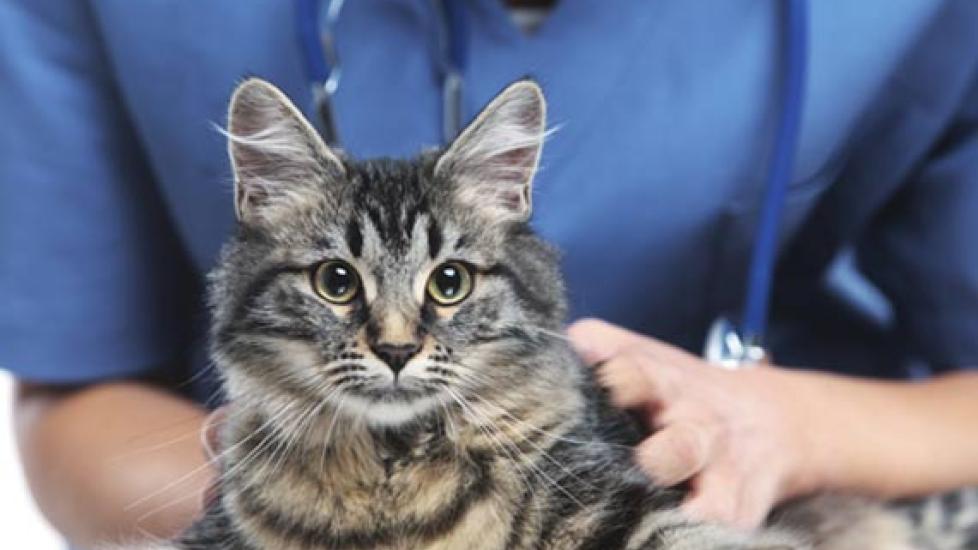Cancer Treatments Can Cure, But Can Also Sicken Those Who Treat
During the final year of my residency in medical oncology, I was required to give chemotherapy to my patients with cancer. One case that stands out is a cat I treated with intralesional chemotherapy for a recurrent fibrosarcoma.
As a typical resident, I possessed an inappropriate level of enthusiasm about this task and I asked one of my colleagues to take pictures of me performing the treatment.
In one picture I’m mixing two syringes: One contains sterile sesame oil, which provides a repository for the chemotherapy to remain in the tissue after injection. The other contains carboplatin chemotherapy.
In the next picture, I’m injecting the sesame oil/chemotherapy mixture into the surgical scar on the cat’s head. The only personal protective equipment I’m wearing in either picture is a pair of nitrile gloves.
I had a healthy respect for the hazards related to chemotherapy, but I primarily focused on those related to side effects. I knew which drugs were vesicants versus irritants (i.e., severe blisters versus annoying rashes), and the deleterious effects they could wreak on bystander organ systems.
What I lacked was an understanding of the risks that unsafe handling of chemotherapy posed to my health. In fact, the bulk of my awareness of chemotherapy safety came following my board certification.
The treatment of cancer in pets is far more popular today than ever before. Yet there is a lack of concurrent education of the risk chemotherapy poses to the healthcare team during its preparation, administration, and cleaning of eliminations.
Studies characterizing the impact of secondary exposure to chemotherapy on human oncology health workers with regard to cancer prevalence, reproductive risks, and acute toxicities show little risk.
However, markers of toxicity and measurable levels of drugs and their metabolites have been found in the urine of healthcare workers exposed to chemotherapy. This occurs in highly trained and experienced individuals working in human medicine, where, unlike working with animals, contact with bodily eliminations (a major source of contamination) is minimal.
Veterinary studies regarding environmental risks from chemotherapy are lacking. We know dogs undergoing chemotherapy treatment for lymphoma and mast cell tumors have measurable levels of vincristine, vinblastine, and doxorubicin—all chemotherapy medications—in their urine at up to 3, 7, and 21 days after administration, respectively. This is a serious consideration for potential exposure.
Pet owners ask a lot of questions about chemotherapy and what to expect as their dog or cat goes through treatment. Surprisingly, I’ve never been asked about what ‘s done to ensure the treatments are done safely and without risk to their animal or to the staff. Either they haven’t considered the consequence of a lack of experience with the treatments or, more likely, they simply assume correct measures will be taken.
Here are some key points related to safe administration of medications that chemotherapy clinics should employ on a regular basis:
Experience is key:
Any technician or doctor giving chemotherapy must be adequately trained in the safe handling and administering of the drugs. Persons administering drugs need to be familiar with their mechanisms of action, correct dosage and route of administration, side effects, and potential routes of exposure.
Use a hood:
A class IIB or III, biological safety cabinet contained in a separate room, with venting to the outside should be used for the preparation of chemotherapeutic drugs, including oral medications. Using the appropriate biosafety hood ensures inadvertent contact does not occur through aerosolization during the preparation of drugs, or in case of accidental spill.
Use a closed, contained system:
There are several options for commercially available adaptors for syringes and vials used in the preparation and administration of chemotherapy. These systems reduce the risk of aerosolization of vapors from drug containers to ensure no drug leaks out of the syringe into the air or on the staff or pet’s skin during treatment. These systems do not circumvent the need to use a hood as mentioned above.
Dress for the job:
Individuals should wear powder-free latex or nitrile gloves along with the appropriate chemotherapy resistant face shields and eye protection, and a closed-front, elastic cuffed, non-permeable, lint-free gown.
Be prepared:
Should a chemotherapy spill occur, commercially available spill kits are recommended, and staff must be trained in the appropriate way to clean bodily fluids from patients and also any surfaces coming into contact with chemotherapy during its preparation and administration.
I’ve always sought to deliver the highest standard of care for my patients. Time and experience allowed me to recognize the importance of extending that goal to provide the highest level of safety for my co-workers, owners, and myself. If your pet receives chemotherapy, I would urge you to inquire about the safety measures taken to ensure that those involved in your pet’s treatment are doing the same.

Dr. Joanne Intile
